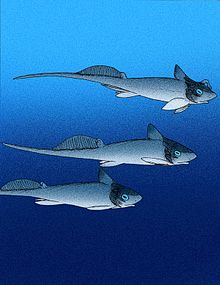- Ctenurella
-
Ctenurella
Temporal range: Late Devonian
C. gladbachensis Scientific classification Kingdom: Animalia Phylum: Chordata Class: †Placodermi Order: Ptyctodontida Genus: Ctenurella Ctenurella ("Little Comb Tail") is an extinct genus of ptyctodont placoderm from the Late Devonian of Germany (Orvig 1960).
As with other ptyctodonts, the armor of Ctenurella was reduced to a few thin plates on the head and shoulder region. It was also relatively small for a placoderm, at just 13 centimetres (5 in) in length. It had two dorsal fins, with that at the rear of the body being relatively long and low, and large pectoral and pelvic fins. Most ptyctodonts are presumed to have fed on the ocean floor, but the well-developed fins of this genus indicate that it probably also swam in open waters.[1]
Ctenurella had a long, whip-like tail, large eyes and robust upper and lower jaw tooth plates. It also had hook-shaped sex organs, known as claspers in males. Since all of these features are also found in the unrelated living chimaeras, they are thought to be an example of convergent evolution.[1]
Ctenurella gardineri was renamed as the new genus Austroptyctodus by Long (1997) in his review of the Gogo ptyctodontid species, relegating the genus Ctenurella as only coming from the German sites. A new description of Ctenurella gladbachensis by Long (1997) showed that the original restoration had wrongly restored the skull-roof as the central bones do in fact meet each other behind the nuchal plate.
Ptyctodontid placoderms recently have been shown to give birth to live young, with two examples, Materpiscis and Austroptyctodus, both from the Gogo Formation of Western Australia, showing the presence of unborn embryos within the mother fishes (Long et al. 2008)
References
- Long, J.A. 1997. Ptyctodontid fishes (Vertebrata, Placodermi) from the Late Devonian Gogo Formation, Western Australia, with arevision of the genus Ctenurella Orvig, 1960. Geodiversitas 19 (3): 515-555.
- Long, J.A., Trinajstic, KJ., Younbg, G.C. & Senden, T. 2008. Live birth in the Devoniajn period. Nature 453: 650-652.
- Orvig, T. 1960. New finds of acanthodians, arthrodires, crossopterygians, ganoidsa nd dipnoans in the Upper Middle Devonian Calcareous Flags (Oberer Plattenkalk) of the Bergisch-Gladbach Paffrath Trough. Part 1. Palaontologische Zeitschrift 34: 295-335.
This article about a placoderm is a stub. You can help Wikipedia by expanding it.
